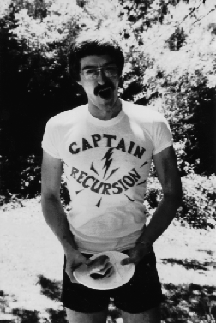
Dr. Don Stanat, dressed as Captain Recursion, celebrates the completion of COMP 114 in 1981. (Photo: Mike Pique, © Department of Computer Science, UNC-Chapel Hill) |
Faculty trained in CSThe next three years saw considerable expansion in faculty members trained in computer science.By 1967-68, Carl Page had returned to Michigan to avoid our allergens. Walter Sedelow became dean of Library Science (now Information and Library Science), but continued to teach in the Department. Dick Brewer served the first of his two years as instructor, on an appointment joint with Journalism. Tom Gallie visited in the Fall semester from Duke. John Sanderson visited in the Spring semester from the University of Adelaide. At the close of the year Akira Nakamura returned to Japan.
|
The Department began to enroll Ph.D. students officially, and received its first terminal for computer-aided instruction (CAI). Fred complained to Dean J. Charles Morrow that there was no budget for laboratory equipment. There wasn't nearly enough space, either.
In 1968-69, I joined the Department as its second full professor. My work had been in switching theory, computer architecture, performance evaluation, and computer-aided instruction. Also a student of Aiken, I had known Fred at both Harvard and IBM. Demetrius Koubourlis of Slavic Languages taught a programming course for us in the Spring semester, as he did in each of the two succeeding Spring semesters. Derek Henderson, of the University of the Witwatersrand (in Johannesburg), a doctoral student of mine and the first computer science professor in Africa, was a Visiting Distinguished Lecturer. Our space crunch was relieved by the allocation of most of New West Hall, although we did not move until after the academic year had ended. A particularly significant event was the award in May 1969 of the first two Ph.D. degrees, to Paul Oliver and Jan Prokop.
The year 1969-70 saw the arrival of yet three more faculty members: Hal Hanes, Gerry Fisher, and Vic Wallace. Hal came from Earlham College as a one-year visitor; Gerry came for longer, but resigned after one year to go to the Illinois Institute of Technology. Vic's research was in interactive computer graphics and numeric computation; he stayed for seven years before moving on. For the first time, we taught a course through the Evening College (now the Division of Continuing Education).
It was not the faculty alone, of course, that grew. Over the four years from 1965-66 to 1969-70, student numbers soared. The average number of graduate students in the Department quadrupled from 15 to 63. It would take 20 more years for it to double from there. The total number of registrations in courses (including thesis and dissertation research) taught by the Department rose from 306 to 1214. Figure 1 and Figure 2 show the increases in those figures through the present. No students are shown for 1964-65; in that year our graduate students were registered through Statistics. Growth in faculty is shown in Figure 3. Tenure-track faculty are those with the one- or two-word titles Instructor, Assistant Professor, Associate Professor, and Professor. Research faculty are those in whose titles the word Research precedes the rank. They are typically on fixed-term, soft-money appointments, usually with no required teaching. I have included with them a few persons with other types of appointment who have been deeply involved in Department activities. The centerfold display shows the complete chronology of faculty appointments. Faculty are listed alphabetically within the academic year that includes the semester of initial appointment. Shading marks years in which the appointment is as research faculty.
Next Section: "Qualitative Changes"